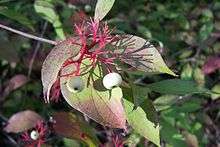Cornus sericea
| Cornus sericea | |
|---|---|
 | |
| Red osier dogwood bearing fruit | |
| Scientific classification | |
| Kingdom: | Plantae |
| (unranked): | Angiosperms |
| (unranked): | Eudicots |
| (unranked): | Asterids |
| Order: | Cornales |
| Family: | Cornaceae |
| Genus: | Cornus |
| Subgenus: | Kraniopsis |
| Species: | C. sericea |
| Binomial name | |
| Cornus sericea L. | |
 | |
| Natural range of subsp. sericea | |
 | |
| Natural range of subsp. occidentalis | |
Cornus sericea, syn. C. stolonifera, Swida sericea, (red osier dogwood[1]) is a species of flowering plant in the family Cornaceae, native throughout northern and western North America from Alaska east to Newfoundland, south to Durango and Nuevo León in the west, and Illinois and Virginia in the east. Other names include red willow,[2][3][4] redstem dogwood,[2][4] redtwig dogwood, red-rood, American dogwood,[2] creek dogwood, and western dogwood.[2]
Description
In the wild, it commonly grows in areas of damp soil, such as wetlands. It is a medium to tall deciduous shrub, growing 1.5–4 m tall and 3–5 m wide, spreading readily by underground stolons to form dense thickets. The branches and twigs are dark red, although wild plants may lack this coloration in shaded areas. The leaves are opposite, 5–12 cm long and 2.5–6 cm broad, with an ovate to oblong shape and an entire margin; they are dark green above and glaucous below; fall color is commonly bright red to purple. The flowers are small (5–10 mm diameter), dull white, in clusters 3–6 cm diameter. The fruit is a globose white berry 5–9 mm diameter.
The Latin specific epithet sericea means "silky", referring to the texture of the leaves.[5]
Cultivation
Cornus sericea is a popular ornamental shrub that is often planted for the red coloring of its twigs in the dormant season. The cultivar 'Flaviramea', with lime green stems, has gained the Royal Horticultural Society's Award of Garden Merit.[6]
Like most dogwood species native to North America, C. sericea can be parasitized by the dogwood sawfly, possibly leaving much of the plant devoid of leaves. A variety of pesticides are effective; however, hand-picking the larvae is also an option.
Uses
C. sericea is frequently used for waterway bank erosion protection and restoration in the United States and Canada. Its root system provides excellent soil retention, it is hardy and provides an attractive shrub even when bare in winter, and its ability to be reproduced by cuttings makes it a low cost solution for large scale plantings.[7][8]
Some Plateau Indian tribes ate the berries to treat colds and to slow bleeding.[9][10]
Known as cansasa in Lakota, the inner bark was also used by the Lakota and other Native Americans as "traditional tobacco", either by itself or in a mixture with other plant materials.[11][12] Among the Algonquian peoples such as the Ojibwe, the smoking mixtures, known as kinnikinnick, blended the inner bark with tobacco,[3] while more western tribes added it to the bearberry leaf to improve the taste.[9][13]
The Ojibwe used red osier dogwood bark as a dye by taking the inner bark and mixing it with other plants or minerals.[2]
Subspecies
It is a variable species, with two subspecies commonly accepted:
- Cornus sericea subsp. sericea - throughout the range of the species. Shoots and leaves hairless or finely pubescent; flower petals 2–3 mm.
- Cornus sericea subsp. occidentalis (Torr. & A.Gray) Fosberg - western North America. Shoots and leaves densely pubescent; flower petals 3-4.5 mm.
Distribution
- Cornus sericea L. has been recorded from counties Antrim and Londonderry in Northern Ireland.[14]
Gallery
-

shrub
-

shrub, fall
-

shrub, winter
-

twigs
-

leaf
-

twig & leaf
-

flowers
-

flowers
-

flowers
-

Cornus: specimen botanicum sistens descriptiones et icones specierum corni minus cognitarum
-

seed
References
- ↑ "BSBI List 2007". Botanical Society of Britain and Ireland. Archived from the original (xls) on 2015-02-25. Retrieved 2014-10-17.
- 1 2 3 4 5 USDA NRCS Plant Guide: REDOSIER DOGWOOD
- 1 2 Hilger, Inez (1951, repr. 1992) Chippewa Child Life and Its Cultural Background, page 63
- 1 2 Hart, Jeff, and Jacqueline Moore (1992). Montana—native plants and early peoples, pages 38-39. Montana Historical Society. ISBN 0-917298-29-2
- ↑ Harrison, Lorraine (2012). RHS Latin for gardeners. United Kingdom: Mitchell Beazley. p. 224. ISBN 9781845337315.
- ↑ "RHS Plant Selector - Cornus sericea 'Flaviramea'". Retrieved 16 June 2013.
- ↑ http://rwmwd.org/index.asp?Type=B_BASIC&SEC=%7B2874F7F4-216C-49AE-A8A0-73062E72001B%7D
- ↑ http://www.northjersey.com/news/139671573_Boro_decides_to_fund_PRC_bank_stabilization_project__.html
- 1 2 Moerman, Daniel E. (1998) "Cornus sericea ssp. occidentallis" Native American ethnobotany Timber Press, Portland, Oregon, page 178, ISBN 0-88192-453-9
- ↑ Hunn, Eugene S. (1990). Nch'i-Wana, "The Big River": Mid-Columbia Indians and Their Land. University of Washington Press. p. 353. ISBN 0-295-97119-3.
- ↑ Herbal lore: Red Osier Dogwood
- ↑ Cutler, Charles L. (2002) Tracks that speak: the legacy of Native American words in North American culture, page 176. ISBN 0-618-06510-5
- ↑ Staff (2009) "Bearberry" Discovering Lewis and Clark The Lewis and Clark Fort Mandan Foundation
- ↑ Hackney, P. 1992. "Stewart & Corry's Flora of the North-east of Ireland." Third edition. Institute of Irish Studies, The Queen's University of Belfast. ISBN 0-85389-446-9 (HB)
External links
| Wikimedia Commons has media related to Cornus sericea. |
- USDA ARS Germplasm Resources Information Network: Cornus sericea
- NRCS: USDA Plants Profile: Cornus sericea
- Profile: Red-osier Dogwood (Cornus sericea) Photos, Drawings, Text. (Wild Plants of Winnipeg from Nature Manitoba)
- Jepson Flora of California: Cornus sericea; subsp. sericea, subsp. occidentalis.
- Cornus sericea ssp. sericea images at bioimages.vanderbilt.edu